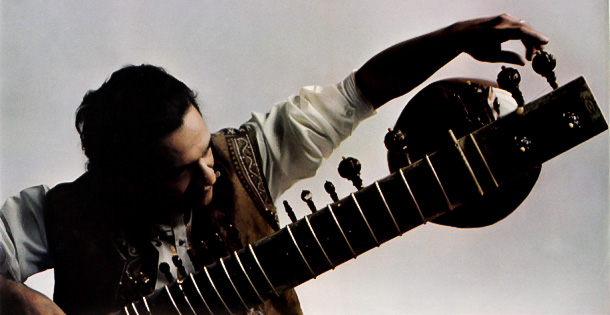Decades before “world music” became an identifiable genre in the U.S., Ravi Shankar travelled the globe carving out a place for his classical sitar music. The traditional Indian instrument resonated with the flower children of the ’60s, and Shankar became an unlikely rock star, developing a relationship with George Harrison and eventually performing at Woodstock. Despite his success in turning a generation on to his culture — or because of it — the raga composer was deeply conflicted about hippie appreciation of Indian musical traditions, drug use, and the possible bastardization of his craft.
Shankar described his cultural moment as “walking on a tightrope” to this magazine in a profile published 50 years ago. “I have had to be so careful in not doing anything to be exploiting the situation,” he said, “To keep the sanctity of the music has been a very difficult job.”
The Beatles weren’t the only pop group using the sitar in the ’60s. Donovan, The Rolling Stones, The Cyrkle, The Mamas and the Papas, and even Elvis utilized its reverberating strings in their recordings. Shankar didn’t disapprove of popular musicians’ embrace of his sacred instrument, but he was distrustful of the pattern of fads in America: “The time has come for Westerners to try to understand and appreciate Indian music on its own terms and not through the music they know. They must take a little more pain to understand all the mystic qualities and not just the speed and excitement.”
That the appeal of Indian musical stylings was largely psychedelic troubled Shankar even more. The association of his rich cultural heritage with drugs like LSD and marijuana was, in his eyes, blasphemous. The cover of Jimi Hendrix’s 1967 album, Axis: Bold as Love, illustrates how Hindu symbolism and iconography could be appropriated by the rebellious counterculture of 1960s America and reimagined for purposes of psychedelia. Shankar was upset to see youth smoking pot and making out during his performances, and he stormed offstage numerous times, according to a 1985 interview with The New York Times.
Keeping the indigenous traditions and intricacies of the sitar while fostering cultural fusion was Shankar’s musical task. Although the Beatles utilized its exotic sound in pop songs like “Norwegian Wood (This Bird Has Flown),” Shankar’s own performances with the instrument sometimes ran seven to nine hours, with avid (sober) music lovers sitting entranced by his raga compositions. Shankar had no interest in learning to play the guitar.
In spite of the self-indulgence of the ’60s youth, Shankar believed the cultural transformation underway was sincere in many ways and could provide a pathway to greater appreciation of Indian customs and, particularly, music. As a performer, his influence spread further than the trends of pop. Shankar performed with the London Symphony Orchestra, John Coltrane, and Philip Glass. He composed film scores for Satyajit Ray, Norman McLaren, and Richard Attenborough, and he even served in the upper chamber of the Parliament of India for six years. Shankar’s daughters, Norah Jones and Anoushka Shankar, are respectively a jazz singer and a sitar musician. Throughout his long life, Shankar transcended the pop culture label of his craft and proved to American audiences that sitar music, as he said in 1968, “is not rock and roll.”

Become a Saturday Evening Post member and enjoy unlimited access. Subscribe now



